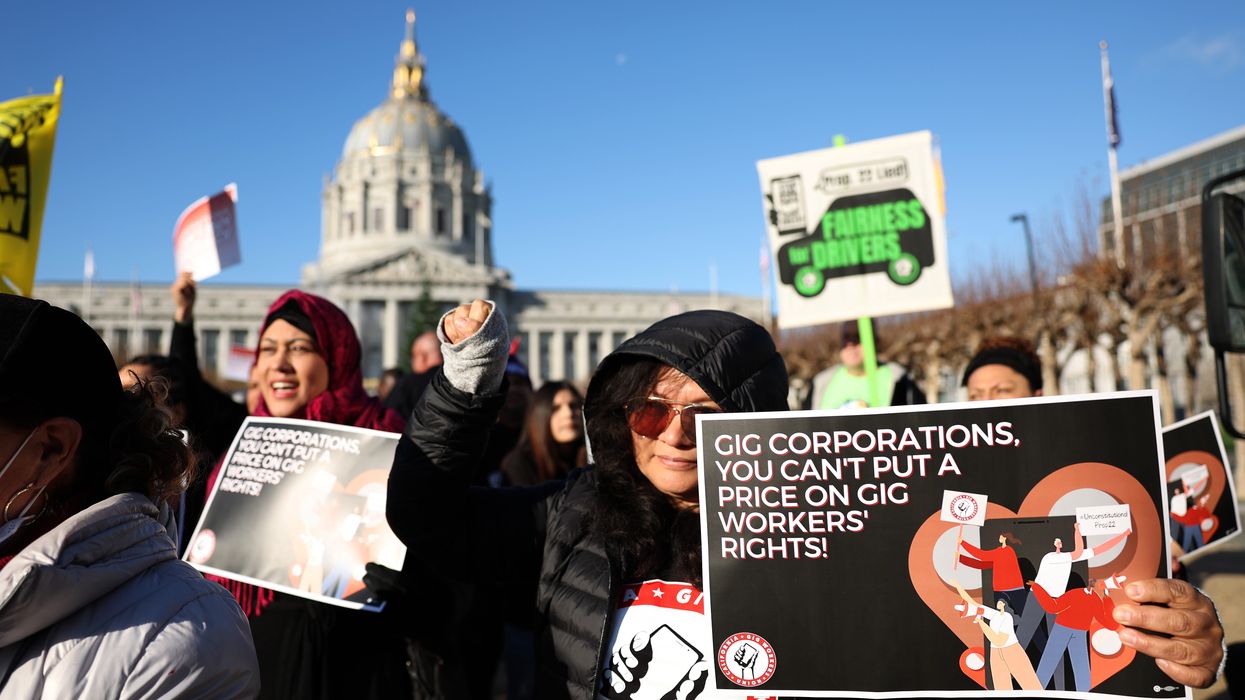Gigs That Work For All
A California pilot program offers a new blueprint for workforce development.
For over a decade, academics and progressive policymakers have been fretting about the “future of work” and the “gigification” of labor. And for good reason. Since the ascendance of companies like Uber, Lyft, DoorDash, and Instacart in the early 2010s, hundreds of thousands of people have taken on the work of fulfilling “gigs” provided by such apps. Consumers have become habituated to getting their rides, groceries, and household goods at the push of a button.
Workers often turn to “gig” jobs because they need flexible work schedules due to caregiving responsibilities or the need for multiple jobs to make ends meet. However, this work is usually low paying, precarious, and unprotected by employment or labor laws. That’s by design, and it’s a big problem: Those laws were created with the intention of protecting just these sorts of workers. The companies behind the apps argue that this is simply the price of flexibility.
There’s no reason that flexible work should require sacrificing the protections, rights, and opportunities provided by employment, like a guaranteed minimum wage and overtime for long hours; the right to a healthy and safe workplace; protections against discrimination and harassment; and insurance against the downside risks arising from the loss of jobs or workplace injuries.
Treating workers as independent contractors without rights and protections has become standard practice for many platform companies. Promoted by venture capital funders, the practice feeds a narrative that the acquisition of skills, experience, and on-the-job savvy—traditionally a responsibility of employers—falls on individual workers to “entrepreneurially” pick up such training on the job. Yet this perspective contradicts a fundamental principle of workforce development, which recognized the wider economic benefits arising from building a skilled workforce.
The Long Beach pilot demonstrates that flexibility can also come with good jobs and opportunities to enhance skills while meeting pressing employer staffing needs.
An innovative public pilot in Long Beach has shown it is possible for gig work to benefit workers, employers, and the broader community. The Workers Lab, an organization that funds innovations for and with workers, and Pacific Gateway, the City of Long Beach’s public workforce board, have invested in a platform called WorkLB. The technology behind the platform, originally developed with the British Labor government, plays a matchmaking role by connecting employers and workers based on needs, skills, and schedules.
Pacific Gateway is demonstrating that flexible schedules and the opportunity to do short-term work can go hand in hand with decent earnings, protections, rights at work, and upward mobility. Moreover, the program shows that such opportunities can also benefit businesses and public agencies looking for workers and seeking to improve the workforce development system.
This simultaneously undermines the dominant narrative of a trade-off between flexibility and workers’ rights, and shows how government intervention can effectively address issues arising from the so-called Gig Economy.
The Long Beach model allows Pacific Gateway to either act as, or delegate the responsibility to vet and oversee workers, ensure proper payroll management, provide healthcare, abide by labor law, and pay for liability insurance.
To participate, employers must be willing to pay the local minimum wage (currently $16.50 per hour in Long Beach), with a markup of 2.5% ($0.40 per hr) to help defray the costs of administration. For workers, this unique model helps them find the best work opportunities based on their skills, interests, and scheduling needs. Whether short or long-term, these work opportunities are W-2 jobs providing good wages, benefits, and labor protections. All that, and flexibility.
Pacific Gateway credentials workers through its formal intake process, awarding them “badges” to market their skills. Unlike traditional, for-profit staffing agencies, which have also proliferated in the gig economy space, that treat workers’ skill levels as proprietary data, Pacific Gateway makes this information readily available to prospective employers.
By using a public workforce agency in this staffing agency role, Pacific Gateway is fulfilling the original intention of the federal Employment Services program—to match workers with employers, connect workers to the appropriate training opportunities, and then place them in actual jobs.
In a reversal of gig work common sense, WorkLB’s app allows workers to review their employers, which helps ensure that Pacific Gateway recruits employers providing good jobs rather than placing workers in exploitative and precarious work. While the app currently does not allow employers to rate the workers, it enables them to track the progression of a worker to incentivize full-time work conversion where desired.
Participating workers in Long Beach report high satisfaction with the program, saying that it provides quality jobs with transparent pay, clear expectations, and legal protections and allows them to demonstrate their skills to prospective employers. Employers get a vetted, skilled workforce for on-demand jobs that serve their longer-term workforce needs. The federal workforce system was created to do this, but perpetually lacks the funding to do so at the appropriate scale.
Given its success thus far, there is growing interest in adopting similar pilots in other parts of the country. Additionally, these pilots may provide a salient avenue for much-needed workforce development at the state and local level that meets both workers' and employers’ needs, especially as the current Trump administration slashes federal programs, such as Supplemental Nutrition Assistance Program, Medicaid, and Temporary Assistance for Needy Families, and mandate greater work requirements that may impact state and local workforce funding. However, the greatest challenge is funding these pilots, especially as federal funding is cut. The Long Beach pilot was primarily funded through philanthropic dollars, but given the need to scale future efforts, public funding is critical. Now is the time for states and localities to think creatively, whether by developing sector-based partnerships with employers and unions where all partners have “skin in the game,” or identifying other public funding streams, to support this growing workforce.
Workers often accept low-paid and precarious gig jobs because they need them to shore up failing household budgets while juggling complicated schedules. The Long Beach pilot demonstrates that flexibility can also come with good jobs and opportunities to enhance skills while meeting pressing employer staffing needs, thereby benefiting workers, families, and the wider community.


